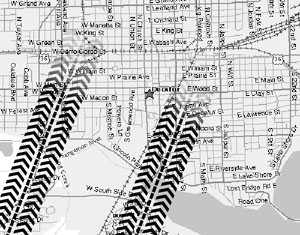|
|
|
|
Firestone
Pulls Out of Decatur
by Michael Feltes |
|
|
 Forty
miles to the west-southwest of Champaign-Urbana, a sinkhole
is growing, slowly but surely. Its name is Decatur. This
city's economy, always reliant on the manual labor of
its residents, has been slowly fading as industry emigrates.
One of the biggest jolts to its psyche came on June 27,
when Bridgestone/Firestone announced that it was closing
its tire manufacturing plant after 38 years in the community.
A total of two thousand jobs has been lost, with a layoff
of 500 in October 2000, and the remaining 1,500 being
thrown out of work over the past four months. For the
past six months the community has been scrambling, first
attempting to keep the plant open in impassioned discussions
with the multinational corporation, then trying to figure
out how to adjust to a smaller economic pie. The final
blow came on December 14, when the last two tires rolled
off the production line. Forty
miles to the west-southwest of Champaign-Urbana, a sinkhole
is growing, slowly but surely. Its name is Decatur. This
city's economy, always reliant on the manual labor of
its residents, has been slowly fading as industry emigrates.
One of the biggest jolts to its psyche came on June 27,
when Bridgestone/Firestone announced that it was closing
its tire manufacturing plant after 38 years in the community.
A total of two thousand jobs has been lost, with a layoff
of 500 in October 2000, and the remaining 1,500 being
thrown out of work over the past four months. For the
past six months the community has been scrambling, first
attempting to keep the plant open in impassioned discussions
with the multinational corporation, then trying to figure
out how to adjust to a smaller economic pie. The final
blow came on December 14, when the last two tires rolled
off the production line.
“This decision was made in response to market conditions,”
says John McQuade, Vice President for Manufacturing of
Bridgestone/Firestone North America. “Recently released
industry information indicates total tire sales will be
off by something like twenty million units this coming
year.” McQuade indicates that the company’s decision to
close the plant had nothing to do with the workers, but
was driven by the larger issue of a downturn in the economy.
Of course, Firestone has been particularly vulnerable
in the face of this recession due to the Ford Explorer
controversy in 2000, when the models of Firestone tires
marketed as standard equipment on the SUV failed repeatedly,
causing hundreds of deaths and casualties in automobile
accidents. The expenses of settling product liability
lawsuits, a recall of 6.5 million ATX, ATX II, and Wilderness
AT tires begun in Augustof 2000, and another still-ongoing
voluntary replacement program for some Wilderness AT tires
have left Firestone in an extremely precarious financial
position.
Mike Griffin is a fiery advocate for the union movement
in Decatur. A millwright by trade, he created the WarZone
Foundation, a support structure for local unions and a
corporate watchdog organization, in 1993. He believes
through his conversations withworkers on the shop floor
that Firestone management had direct knowledge of defects
in the tires produced in the Decatur plant and chose to
send them out the door anyway. “There’s no doubt in my
mind that some of those tires were made by scabs. There
was tires that went out the door that management knew
were not good tires, and as early as late 1996, 1997,
Firestone knew they had a problem with those tires. They
knew they were killing people, and yet they chose to pay
off the lawsuits rather than recall the tires.” Whether
intentional or not, it’s clear that many of Firestone’s
current problems are of its own making.
The closure of the Firestone plant is only the latest
in a series of events impacting Decatur’s blue-collar
workers. According to an article in the Chicago Tribune
(28 June 2001, “Decision Breaks Up a 40 Year Marriage”),
over 10,000 jobs in industry have exited Decatur since
1980. Where have these jobs gone? For Bridgestone/Firestone,
at least, many of the former jobs in the industrial Midwest
and Northeast have been exported to other countries. Firestone's
web site details the locations of its tire-producing facilities
in the Western Hemisphere. Eight of Firestone's sixteen
remaining industrial plants are located outside the United
States: one in Quebec, two in Mexico, and the rest spread
throughout Latin America. Of those plants remaining in
the US, only three are still to be found in the industrial
Midwest, the plants in Bloomington-Normal, Des Moines,
and Akron. The others are located in the South.
Tony Warden and Carl Hughes are in the thick of the struggle
for laborers trying to moveon with their lives. They are
former tire-builders at Firestone who are currently working
as peer counselors at the IETC, a euphemistic acronym
for the unemployment office. They’re acting as guides
through the bureaucratic processes of filing for unemployment
insurance and helping point the way to job opportunities
for their fellow workers.
How is the job market looking for the workers coming out
of the plant? According to Tony, “At the present time,
it looks pretty bleak. Generally, their requirement isabout
half of what they made at Firestone, but even that is
on the high end of the scale. When we say half, we’re
saying $10 to $12 an hour, but when we try to find jobs
to match up, we’re talking $6.75 to $8. It’s pretty discouraging,
and they’re not quite ready to drop that low.”
The severance packages from Firestone are not providing
much of a cushion for the workers, either. Tony continues,
“After taxes and everything, ol’ Uncle Sam took a pretty
good bite of the money, and a lot of them were using it
to pay off some outstanding debt, to prepare themselves
for six months down the road [when unemployment benefits
end], so that money is short-lived. For some of these
people, it’s going to be the last hurrah for Christmas
time. It’s going to be tough, it really is.”
When we speak of those good-paying union jobs, the kind
of work that was being done and the environment in which
the workers labored is not commonly understood by those
who have not been there. Mike Griffin says of it, “I’ve
been in Firestone and worked in there a number of times.
It’s a hellhole. It’s so hot you can’t hardly stand it,
it’s so dirty you can’t ever get clean, and those people
who worked in there for years, I don’t know how they could
do it. They earned every nickel they ever made, I guarantee
you.” Carl Hughes describes it this way: “We worked 12-hour
shifts out there, and we worked two days on, two days
off, three days on, two days off, and your days off altered
every week. The three-day weekends that you had to work,
they was pretty tough, `cause by the end of the third
day you were just done, so the next day off you’d just
try to relax and recuperate, get your body to feel halfway
decent. As far as now, being off, our bodies are starting
to rest and heal up. It’s a different world for us.”
Still, much of the physical strain now being lifted from
the workers’ shoulders is being replaced by mental anguish.
Carl explains. “Some of the guys’ wives are gonna be on
them about getting out real hard looking for a job, and
in some of them there’s going to be divorces, people split
up, and it’s going to be hard on families, it’s going
to be hard on the kids. I think there’s some people who
are not going to be able to recover.”
One can see some fraying around the edges of life in Decatur.
The city's schools are nearing a breaking point. The “new”
Stephen Decatur High School, built at the far northern
edge of town in 1975, in many ways represented the hope
of the city in its future. The building replaced a venerable
edifice downtown where the Civic Center now stands, and
it incorporated many of the newest features in educational
philosophies of the time. It opened with 1,600 students
as a “high school of the future”. In June 2000 it closed
with 400 students, less than a third of its optimal capacity,
reopening as a middle school to replace Roosevelt Middle
School, a building dating back to before World War II.
The district is playing a desperate shell game, closing
schools, redrawing boundaries, and cutting curriculum
and payroll to try and accommodate an ever-shrinking tax
base. The loss of 1,500 union-scale jobs can only accelerate
the economic decay impacting the city.
So how can we fix Decatur's economy? A deceptively short
answer is that the woes of Decatur are inextricably intertwined
with the greater fundamental instability and injustice
of the world economy. The export of industrial production
jobs to poorer countries enables the large multinational
corporations to reap enormous profits. But it leaves workers
in both the wealthy countries, who are earning significantly
less money than before, and those in the “developing”
nations, who without unions to fight for their interests
work unconscionably long hours for starvation wages, without
the wherewithal to purchase the very goods they produce.
It is apparent that nothing short of a fundamental reorganization
of economic structures can allow the people in any Firestone
community - be it Decatur, Oklahoma City, Cuernavara,
Mexico, or San Jose, Costa Rica - to labor and live with
dignity and self-respect.
How do we get there? Supporting alternative economic structures
and union shops with your business is a good step. Dollars
are votes in this society, like it or not, and by using
your resources to support  democratic,
co-operative, worker-owned organizations, you help create
and maintain a more just world. Mike Griffin’s take on
it? “We were the strongest when we had a strong union
movement in this town. We had the best jobs. We had a
higher population back then, too. I think the decline
in Decatur has a lot to do with the decline in the union
movement. There’s no militancy in the union movement.
Don’t make any waves. Don’t piss anybody off. A partnership
with corporate America, your natural enemies? They call
it ‘partnership’, I call it ‘betrayal’. That’s where mending
this union movement has to begin, with the rank and file
saying, ‘Okay, we’ve had enough!’” democratic,
co-operative, worker-owned organizations, you help create
and maintain a more just world. Mike Griffin’s take on
it? “We were the strongest when we had a strong union
movement in this town. We had the best jobs. We had a
higher population back then, too. I think the decline
in Decatur has a lot to do with the decline in the union
movement. There’s no militancy in the union movement.
Don’t make any waves. Don’t piss anybody off. A partnership
with corporate America, your natural enemies? They call
it ‘partnership’, I call it ‘betrayal’. That’s where mending
this union movement has to begin, with the rank and file
saying, ‘Okay, we’ve had enough!’” |
|
|
|





